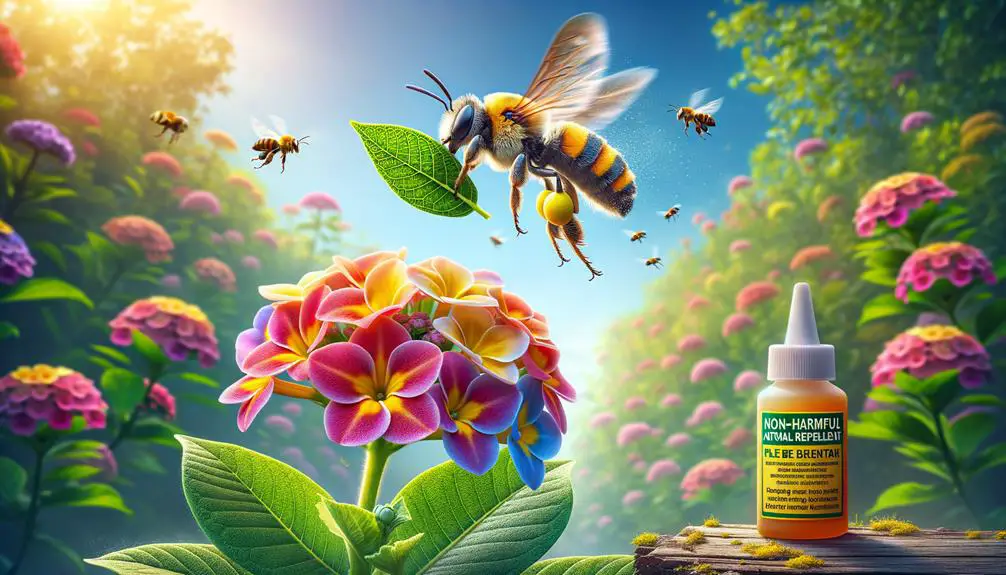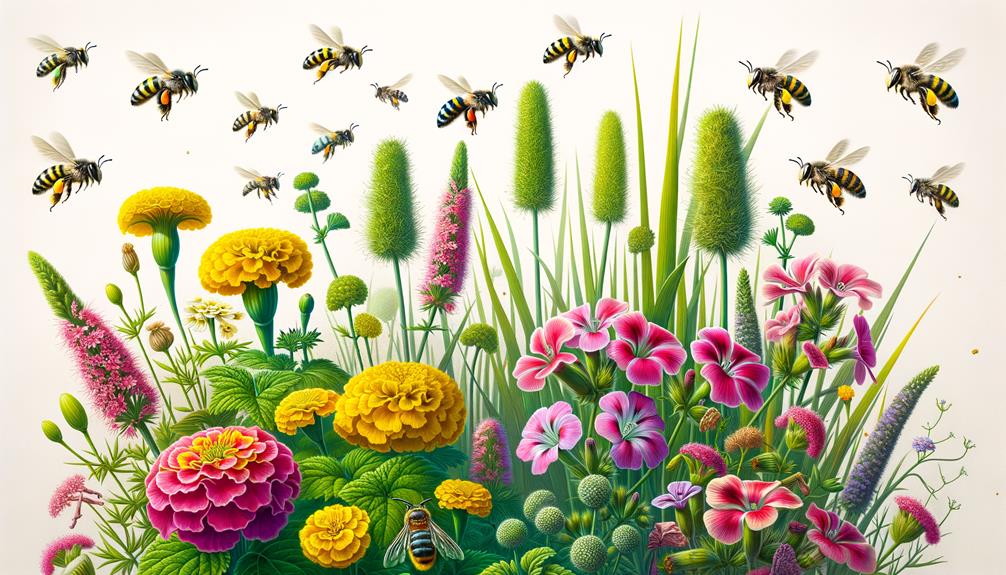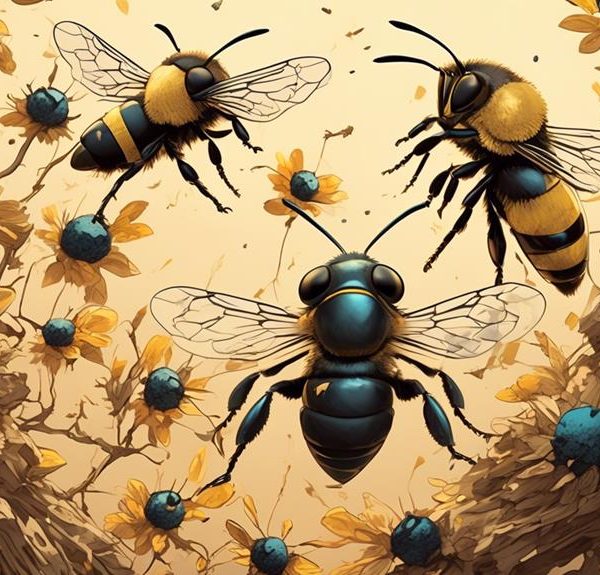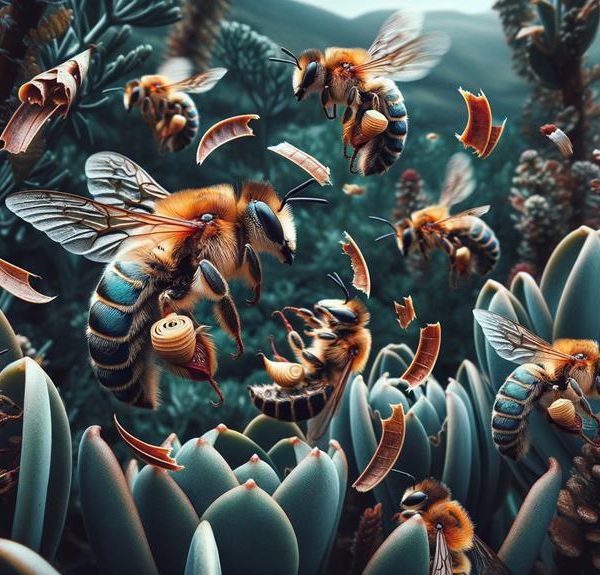Find out how to naturally deter leaf cutter bees from your garden without harming these crucial pollinators, in this insightful guide.

How to Get Rid of Leaf Cutter Bees Naturally
'You know what they say, 'Prevention is better than cure', especially when dealing with leaf cutter bees. These little buzzers, while beneficial to the ecosystem, can wreak havoc on your carefully curated garden.
You're probably wondering how you can protect your plants without causing harm to these important pollinators. Well, you're in luck, because there are natural ways to deter these insects without resorting to harmful pesticides.
Stick around and you'll discover just how you can accomplish this delicate balancing act.'
Key Takeaways
- Leaf cutter bees are solitary creatures that live in small nests and are not aggressive.
- Natural repellents like essential oils and certain plants can deter leaf cutter bees without harming them.
- Maintaining a bee-free garden naturally involves regular cleanup, managing watering schedule, creating physical barriers, and using natural repellents.
- Consider the impact of deterring bees and consult with a local expert if leaf cutter bees are causing significant damage.
Understanding Leaf Cutter Bee Behavior

While you might be eager to rid your garden of leaf cutter bees, it's crucial to understand their behavior first, as these insects play a significant role in pollination. Known scientifically as Megachile, these bees are solitary creatures. They don't live in hives like honeybees but rather in small nests, often in hollow stems or holes in wood.
Leaf cutter bees are harmless to humans and pets. They're not aggressive and will only sting if threatened. Their primary role is to gather pollen and nectar. Interestingly, they carry pollen on their abdomen rather than their legs, a distinctive characteristic that differentiates them from other bees.
A fascinating aspect of their behavior is their leaf-cutting activity. They use their sharp jaws to cut out circular sections from leaves, often causing aesthetic damage to plants. However, they don't eat these leaf pieces. Instead, they use them to line their nests, creating a cozy environment for their eggs.
Understanding this behavior can help you manage their presence in your garden more effectively. Remember, their leaf-cutting activity is merely a nesting behavior and doesn't harm the overall health of your plants.
Natural Repellents for Leaf Cutter Bees

If you're looking to repel leaf cutter bees without harming them, there are several natural methods you can use that are effective and environmentally friendly.
First, consider using essential oils. Bees have a heightened sense of smell and certain scents, such as peppermint, citronella, or tea tree oil, can confuse or deter them. Mix a few drops with water in a spray bottle and mist around the areas where you've seen the bees.
Another method involves the use of certain plants. Marigolds, geraniums, and citronella plants are known to repel bees. Incorporating these into your garden can create a natural barrier against leaf cutter bees.
You can also utilize diatomaceous earth, a naturally occurring substance that can deter a range of pests. Sprinkle this around your plants, but be careful not to harm beneficial insects.
Lastly, bee-safe insect netting can provide a physical barrier without causing harm. Covering your plants with this netting will prevent bees from reaching them.
Garden Strategies to Deter Bees

Beyond the use of natural repellents, adapting your gardening techniques can also help deter leaf cutter bees from your plants. By implementing strategic gardening practices, you can create an environment that's less appealing to these insects.
Below is a tabular representation of some effective strategies:
Strategy | Description | Why It Works |
|---|---|---|
Plant Selection | Choose plants that aren't attractive to leaf cutter bees. | These bees prefer certain plants, avoiding others. |
Garden Hygiene | Regularly clean up fallen leaves and debris. | This reduces the places where bees can nest and lay eggs. |
Water Management | Avoid overwatering your plants. | Damp conditions attract these bees. |
Timing | Plant your seeds earlier or later in the season. | Leaf cutter bees are most active in mid-summer. |
Physical Barriers | Use row covers or plant netting. | This can prevent bees from reaching your plants. |
Plant Choices to Discourage Leaf Cutter Bees

You can shoo away leaf cutter bees from your garden simply by being selective about the plants you choose to grow. These bees are attracted to plants that provide a source of nectar or pollen, such as sunflowers, roses, dahlias, and azaleas. By avoiding these plants, you can naturally reduce the attraction of your garden to these bees.
Instead, opt for plants that are less attractive to leaf cutter bees. This includes plants that have less nectar or pollen, such as begonias, impatiens, and marigolds. You'll find that these plants still add vibrant color and beauty to your garden, but without attracting the unwanted guests.
Also, consider incorporating plants that deter bees. Strongly scented herbs like mint, basil, and rosemary can repel bees, as they find the powerful aroma overwhelming. Similarly, plants like geraniums and wormwood are also known to be unattractive to bees due to their strong scent.
Maintaining a Bee-Free Garden Naturally

After selecting the right mix of plants to deter leaf cutter bees, it's equally important to employ additional natural methods to keep your garden bee-free. Regular maintenance like removing dead wood, pruning old branches, and cleaning up debris can help eliminate nesting sites.
Here are some natural strategies presented in a simple table:
Strategy | Description |
|---|---|
Regular Cleaning | Remove debris, dead leaves, and branches frequently. |
Water Control | Bees are attracted to water. Manage your watering schedule to discourage them. |
Barrier Creation | Use netting or row covers to create a physical barrier. Ensure it's bee-proof. |
Natural Repellents | Certain scents like peppermint or cinnamon can repel bees. Use them around your garden. |
Companion Planting | Plant bug-repelling plants like marigolds or garlic near your precious crops. |
Conclusion
So, you've got the know-how to naturally manage leaf cutter bees now. Remember, understand their behavior, use natural repellents, and adopt garden strategies that discourage them.
Choose plants wisely, with their preferences in mind. Maintenance is key to a bee-free garden. It may take time, but these natural methods will surely keep your foliage intact.
Your garden is a labor of love, and you're well-equipped to protect it. Best of luck, gardener!


